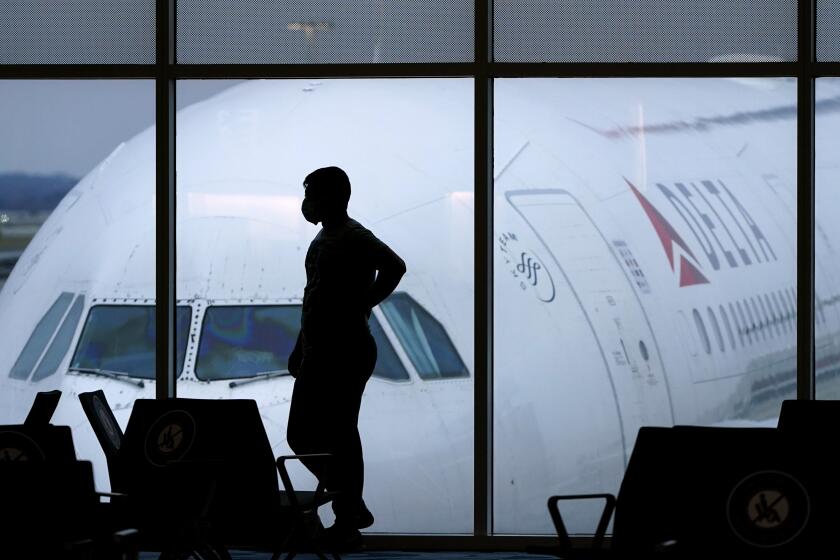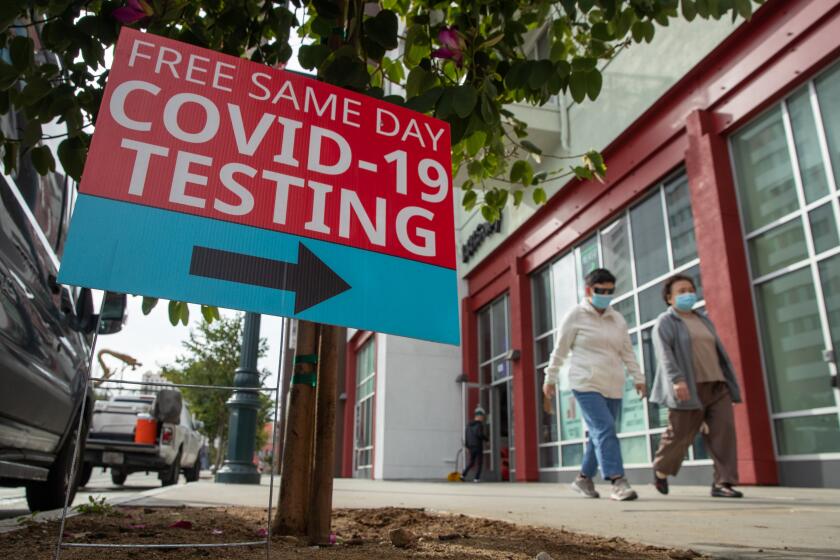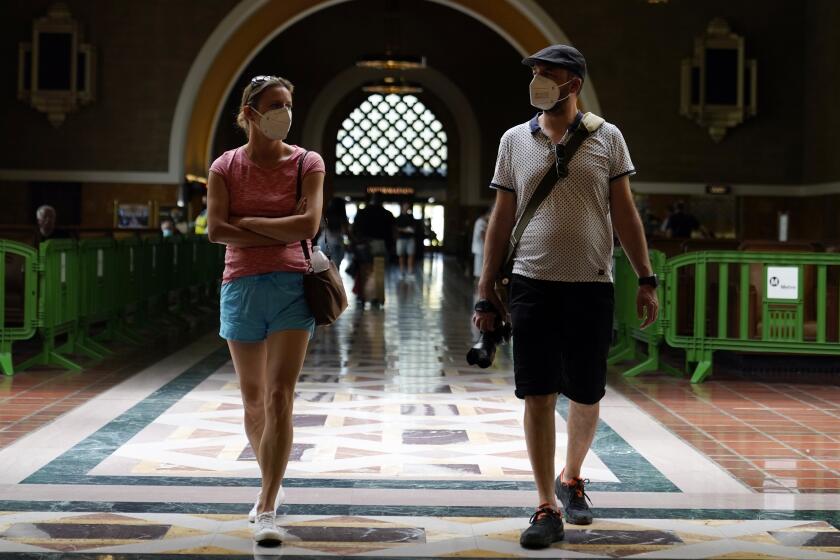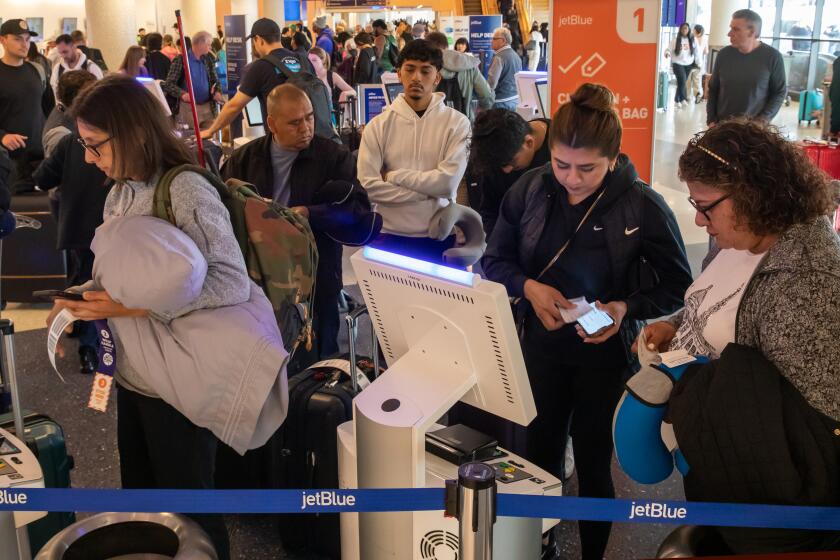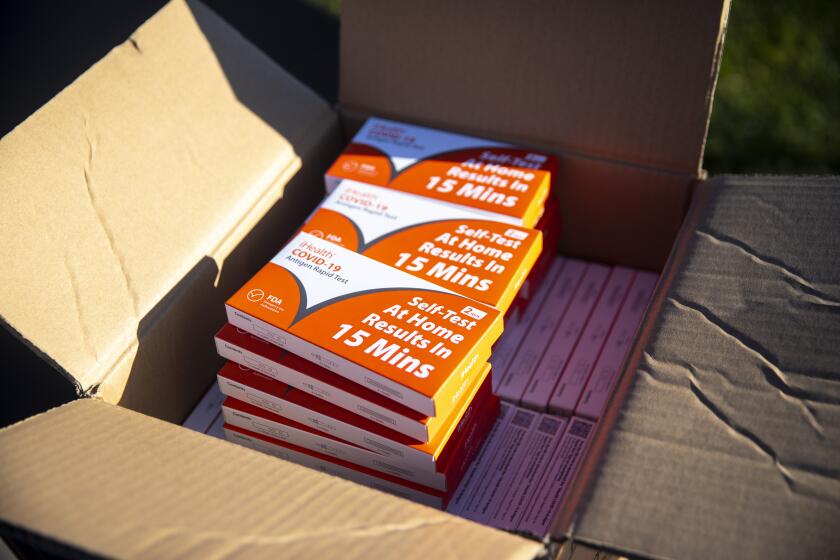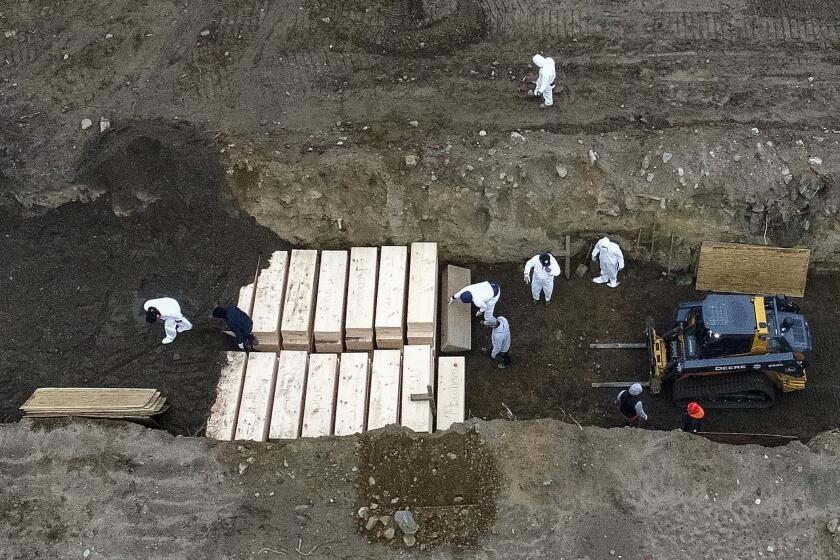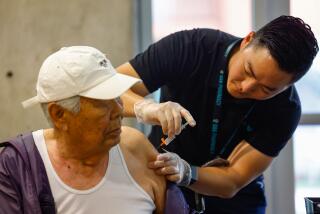With coronavirus on the upswing in California, new vaccine coming sooner than expected
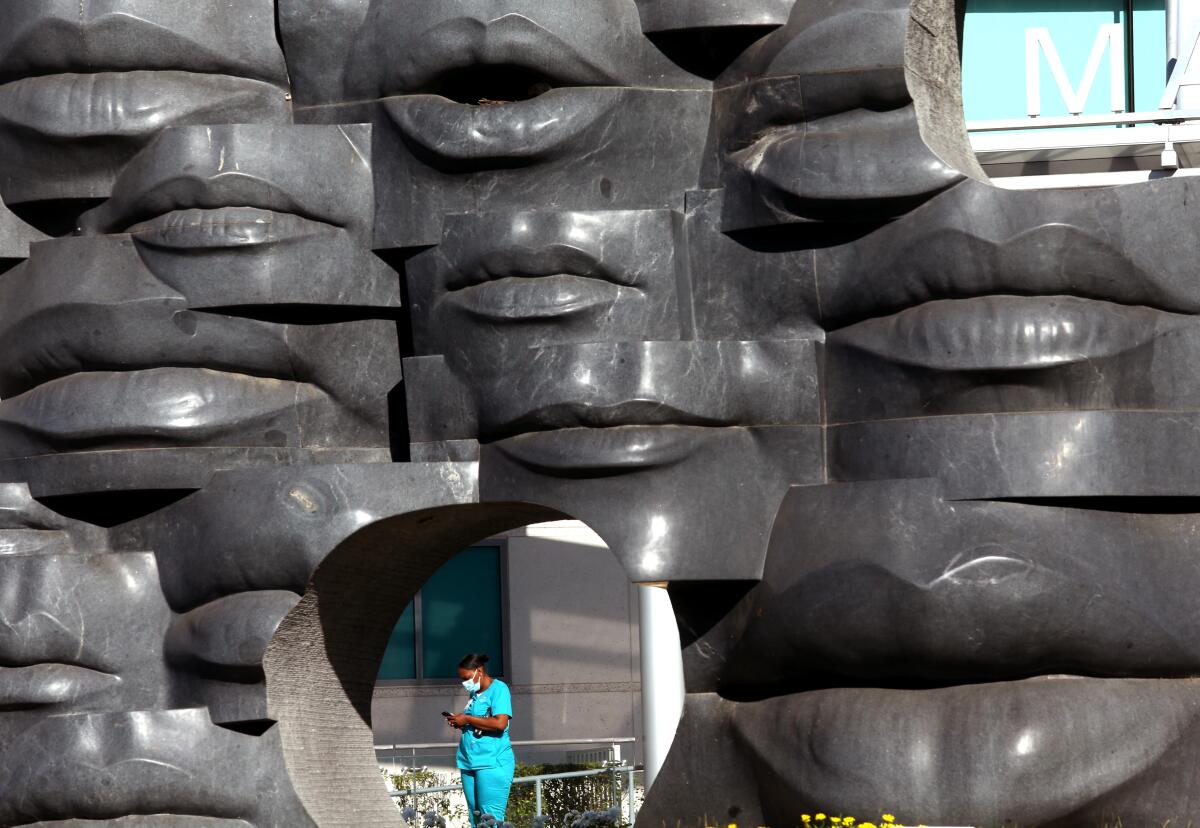
- Share via
With coronavirus cases increasingly on the upswing across California and the nation, an updated COVID-19 vaccine is expected to come out even earlier than expected.
Coronavirus transmission has been rising this summer and hospitalizations, while still low, have recently started to tick up as well.
In Los Angeles County, COVID-19 levels have risen for the fifth consecutive week, with the number of newly reported infections likely growing because of travel, the back-to-school season and new Omicron subvariants, health officials said.
New outbreaks are up at L.A. County’s nursing homes, and one Hollywood studio temporarily imposed a mask mandate after several employees were infected. Nationally, there were 12,613 weekly COVID-19 hospitalizations for the week that ended Aug. 12 — double the number from the start of this summer, but just one-third of the level seen at this time last year.
Lionsgate in Santa Monica is requiring masks for some workers as COVID-19 outbreaks ramp up in the state and nationwide.
The U.S. Food and Drug Administration said this year’s updated version of the COVID-19 vaccine is likely to come out by the middle of next month, a bit earlier than the late September timeline previously announced by the Department of Health and Human Services.
The earlier-than-expected arrival became apparent after the U.S. Centers for Disease Control and Prevention scheduled a Sept. 12 meeting of its Advisory Committee on Immunization Practices, a likely indication that the vaccine would become available shortly afterward.
The latest version of the vaccine is designed against the Omicron subvariant XBB.1.5, unofficially known as Kraken. Unlike last year’s formulation, a bivalent vaccine that was designed against both the ancestral coronavirus strain and the BA.5/BA.4 Omicron subvariants that were circulating at the time, the upcoming vaccine will be monovalent, specifically designed against XBB.1.5.
Kraken, dominant as of this spring, has seen other upstart subvariants rise to compete against it, such as XBB.1.16 (unofficially refered to as Arcturus) and EG.5 (also known as Eris). The differences between these subvariants are relatively minor, and it’s expected the new vaccine will be effective against all three.
It’s possible the Eris subvariant, formally known as EG.5, may have even further immune-escape advantage than other members of the Omicron coronavirus family.
But officials are closely watching another subvariant that has raised more questions: BA.2.86, nicknamed Pirola, after an asteroid.
In a CDC risk assessment, the agency said that Pirola “may be more capable of causing infection in people who have previously had COVID-19 or who have received COVID-19 vaccines.”
The effectiveness of the upcoming vaccine against Pirola is still being evaluated, the CDC said Wednesday, but the agency still expects the new version will be effective at reducing severe disease and hospitalization.
“At this point, there is no evidence that this variant is causing more severe illness. That assessment may change as additional scientific data are developed,” the agency added.
Updated versions and new vaccines for COVID-19, influenza and respiratory syncytial virus will be rolled out this fall.
Unlike more recently identified subvariants, which might have one or two mutations that distinguish them from earlier versions, Pirola has 36 distinct mutations from XBB.1.5, “which is making people raise their eyebrows,” said Dr. Peter Chin-Hong, a UC San Francisco infectious-disease expert.
“BA.2.86,” he said, “is so different that people worry that the vaccine in the fall won’t be a perfect match — but nevertheless, it will still protect people against serious disease.”
“And who knows if it’s even going to become ruler of the roost? It really hasn’t taken off so far that we know,” Chin-Hong added. “But again, sequencing always lags and not a ton of people are doing sequencing anymore around the world.”
Very few cases of Pirola have been identified in the U.S. thus far, and the subvariant has yet to be detected in Los Angeles County. But in some parts of Europe, Pirola now makes up perhaps 1% to 2% of cases, and the fact that it’s on more than one continent suggests it is spreading, Chin-Hong said.
Amid the latest coronavirus uptick in California, health officials reiterate the same advice: Masks work, but it’s a personal preference whether to wear them.
Still, those infected with the Pirola subvariant have so far experienced generally mild symptoms, Chin-Hong said. Based on what’s currently known, if Pirola does become dominant, “at some point, it may fuel another round of transmission, and may find people who are ‘no-vids’’’ — people who have never been infected — “or people who are more vulnerable to getting ill,” Chin-Hong said.
Regardless of the new mutations in Pirola, Chin-Hong said, the anti-COVID therapeutic drugs Paxlovid and remdesivir should remain effective.
Generally speaking, Chin-Hong said many people who have been infected with the coronavirus this summer did not require hospitalization, likely because they were vaccinated, had been previously infected, or both. Even those COVID-19 patients who have been hospitalized, Chin-Hong said, are generally requiring shorter stays than earlier in the pandemic.
Still, those who are being hospitalized tend to be older and those who haven’t received a COVID-19 booster shot in the past year — meaning they are not considered “up to date.”
Test positivity has ticked up in L.A. County in recent weeks, though we’re still well below peak COVID levels. If you get COVID now, here’s how to treat it, how long to isolate, how to get Paxlovid, and more information on getting healthy.
Areas of the country that are seeing particularly notable increases in new weekly COVID-19 hospitalizations are in the South, CDC data show. In California, there were 1,930 new weekly COVID-19 hospitalizations for the week that ended Aug. 12. That’s more than a 60% increase from the start of the summer, but still relatively low historically.
Coronavirus-positive hospitalizations are also increasing in L.A. County. For the week that ended Aug. 19, there were an average of 422 such patients in hospitals per day, a nearly 30% increase from the prior week.
Coronavirus levels in L.A. County wastewater are at about 28% of the peak seen last winter, during the region’s last significant spike. That concentration has been increasing since early July, when coronavirus levels were at about 8% of this past winter’s peak.
“While hospitalizations are increasing, the current levels are still far lower than what was seen in 2022 during the summer peak, when there was an average of 1,287 COVID patients hospitalized each day,” the L.A. County Department of Public Health said.
Unsolicited COVID-19 tests are being sent to people with Medicare as part of a national scam. What should you do next and what resources are available?
There were 39 new coronavirus outbreaks in skilled nursing facilities in L.A. County for the most recent week of data available, up from 20 the prior week. “While resulting hospitalizations and deaths among skilled nursing facility residents are lower than at other points during the pandemic, nonetheless, increased transmission of COVID-19 at nursing homes carries heightened risk for frail elderly,” officials said.
In a blog post, Dr. Eric Topol, director of the Scripps Research Translational Institute in San Diego, said that recent trends underscore how “the pandemic isn’t over.”
Topol described the recent increase in transmission as a “wavelet” that could pick up steam but is more likely related to waning immunity and behavior than the latest subvariants.
“The fact that the inexorable evolution of the virus continues — to find new hosts and repeat hosts —cannot be ignored,” he wrote.
“At the moment there’s no reason for alarm. ... What we’ll see in the weeks ahead is whether BA.2.86 takes hold or not. If it does, that will pose a new challenge, and make the ‘updated’ booster shots considerably less helpful than what was conceived when XBB.1.5 was selected as the target,” Topol wrote.
With the emergency phase of COVID-19 over, a Los Angeles Times analysis shows how the pandemic took different tolls on L.A. County and New York City.
People who are infected with COVID-19 should stay home for at least five days following their first onset of symptoms or first positive test, whichever comes first, L.A. County health officials said.
County health officials urged people at high risk, and those who spend time with them, to consider precautions against infection, such as wearing a mask in crowded indoor settings, especially those with poor ventilation, and on public transit.
It’s also important to test for an infection when symptomatic or after an exposure to someone with COVID-19, staying home when sick, and seeking anti-COVID drugs if infected.
Californians who don’t have insurance or are having a hard time getting a prescription for anti-COVID medication can make a free phone or video appointment through the state’s COVID-19 telehealth service, reachable through sesamecare.com/covidca or by calling (833) 686-5051.
L.A. County has similar free telehealth services, which are accessible at (833) 540-0473. Free at-home COVID tests also can still be picked up at county libraries and vaccination sites operated by the county Department of Public Health, as well as at many food banks and senior centers.
More to Read
Sign up for Essential California
The most important California stories and recommendations in your inbox every morning.
You may occasionally receive promotional content from the Los Angeles Times.

